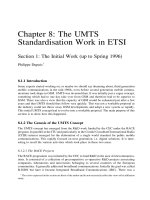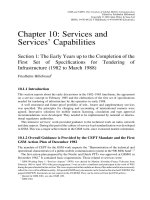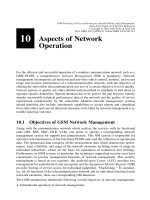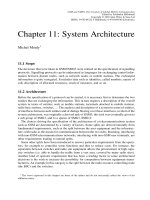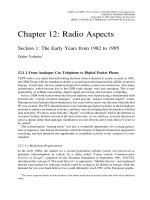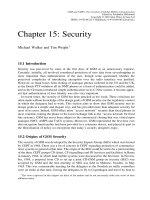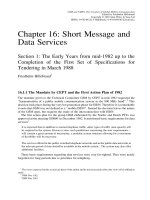GSM and UMTS (P10)
Bạn đang xem bản rút gọn của tài liệu. Xem và tải ngay bản đầy đủ của tài liệu tại đây (228.81 KB, 38 trang )
Chapter 10: Services and
Services’ Capabilities
Section 1: The Early Years up to the Completion of the
First Set of Specifications for Tendering of
Infrastructure (1982 to March 1988)
Friedhelm Hillebrand
1
10.1.1 Introduction
This section reports about the early discussions in the 1882–1985 timeframe, the agreement
on a service concept in February 1985 and the elaboration of the first set of specifications
needed for tendering of infrastructure by the operators in early 1988.
A well structured and future-proof portfolio of tele-, bearer and supplementary services
was specified. The principles for charging and accounting of international roamers were
agreed. Innovative solutions for mobile station licensing, circulation and type approval
recommendations were developed. They needed to be implemented by national or interna-
tional regulatory authorities.
This intensive services’ work provided guidance to the technical work on radio, network
and data aspects. During this period the culture of service-lead standardisation was developed
in GSM. This was a major achievement in the GSM work, since it ensured market orientation.
10.1.2 Overall Guidance is Provided by the CEPT Mandate and the First
GSM Action Plan of December 1982
The mandate of CEPT for the GSM work requests the ‘‘Harmonisation of the technical and
operational characteristics of a public mobile communication system in the 900 MHz band’’.
2
The first action plan prepared by the Nordic and Dutch PTTs was approved at GSM#1 in
December 1982.
3
It contained basic requirements. Those related to services were:
1
GSM Working Party 1 ‘‘Services Aspects’’ (WP1) was chaired by Martine Alvernhe (France Telecom) from
February 1985 to April 1991 with great engagement. I was an active contributor and participant in the work of WP1
during the period treated in this section. The views expressed in this module are those of the author and do not necessarily
reflect the views of his affiliation entity. All quoted GSM Plenary documents can be found on the attached CD ROM. The
quoted GSM WP1 documents are not copied on the CD ROM. They can be retrieved from the ETSI archive.
2
Quoted in GSM 2/82, see also GSM 1/82.
3
GSM 2/82.
GSM and UMTS: The Creation of Global Mobile Communication
Edited by Friedhelm Hillebrand
Copyright q 2001 John Wiley & Sons Ltd
ISBNs: 0-470-84322-5 (Hardback); 0-470-845546 (Electronic)
10.1.2.1 Basic requirements for GSM services in the first action plan (December 1982)
4
:
†
‘‘ Mobile stations can be used in all participating countries, preferably all CEPT countries
†
It is expected that in addition to normal telephone traffic, other types of services (non-
speech) will be required in the system.
†
..state-of-the-art subscriber facilities at reasonable cost.
†
The services and facilities offered in the public switched telephone networks and the
public data networks...should be available in the mobile system.
†
The system may also offer additional facilities (e.g. special barring functions, rerouting of
calls and special message handling facilities).
†
It should be possible for mobile stations...to be used on board ships, as an extension of the
land mobile service.
†
The system shall be capable of providing for portable (handheld) mobile stations, but the
consequential impact on the system shall be assessed.
†
..voice security...must be taken into account.’’
GSM#1 also discussed whether a harmonisation of the emerging analogue 900 MHz interim
systems
5
should be studied. It was concluded that this would not be reachable due to the
necessary short implementation periods and the commitments made by the PTTs and that the
work should be focussed on a new mobile communication system. This was an important
decision on a viable work focus.
10.1.3 Discussions from the Beginning of 1983 to the End of 1984
(GSM#2–6)
10.1.3.1 Interactions with CEPT Working Group Services and Facilities
CEPT working group services and facilities produced several versions of a report on mobile
services. The report gave rise to many questions by GSM. Towards the end of 1984 GSM
came to the conclusion that this dialogue would not lead to results, since the CEPT group
services and facilities had too broad a scope and a lack of know-how in mobile communica-
tion. It was agreed to make their own efforts in GSM and a special focus on services was
agreed for GSM#7 in February/March 1985.
10.1.3.2 The ‘‘Coexistence Between Vehicle-borne and Hand-held Stations’’
The big theme of the period 1982–1985 was the ‘‘ Coexistence of vehicle-borne and hand-held
stations’’ . This was a hot issue, since most mobile systems had a very limited capacity and
used call duration limitations. No existing European system supported hand-helds. This
existed only in the American AMPS.
6
Several countries in Europe planned the support of
hand-helds in analogue systems.
7
In others, mainly in the centre of Europe, spectrum was
much scarcer due to the large demand by the many large armed forces in cold war times.
GSM and UMTS: The Creation of Global Mobile Communication264
4
GSM 2/82.
5
NMT-900 in the Nordic countries, TACS (an AMPS derivative) in the UK and later in Italy and Austria, later the
planned Franco-German S900 system.
6
Advanced mobile phone system.
7
The Nordic countries planned the introduction of NMT900 mainly for this purpose. The UK planned the
introduction of TACS (an AMPS derivative) with an integrated hand-held support. France and Germany planned
a 900 MHz interim system IS900 which would also support hand-helds.
Several delegates clearly proposed not to admit hand-helds. Should there be a sufficient
demand, a separate system evolved from cordless systems working in another part of the
spectrum should be developed.
‘‘ ... several people believe that the majority of the mobile stations will be hand-held
portables.’’
8
A special working party was set up during GSM#5 and 6. They produced an
exhaustive study.
9
It was realised that personal communication would be an important future
demand. Issues like in-building coverage were studied. The fears on the negative effect of
hand-helds on high-rise buildings and in aircraft on the spectrum re-use pattern and this
network capacity were addressed.
In the end ‘‘the meeting agreed that the GSM mandate (Doc 2/82) clearly states that hand-
held stations should be catered for in the system.’’
10
This was to my judgement a decision effected by exhaustion of the participants. But it
opened the way to GSM as we know it today, where hardly any dedicated vehicle-borne
stations exist any more. But the discussion continued for some time before it was formally
closed (see paragraph 10.1.5.4.1)
10.1.3.3 Discussions on Other Issues
Other service related issues which attracted substantial interest were market surveys, the
discussion of traffic models and a comparative evaluation of the tariffs in existing systems
which showed large differences in the charging criteria and charging levels.
11
10.1.4 The First Concept for Services Agreed in February/March 1985
(GSM#7)
10.1.4.1 A Concept Proposal by Germany and France
A major step forward in the definition of services was reached at GSM#7 (February/March
1985) in Oslo. Germany and France presented a input document
12
which proposed to use the
ISDN differentiation of tele-, bearer and supplementary services and to use the description
method using attributes within the GSM framework.
The document clearly stressed that radiotelephony would be the most important service.
13
It proposed realistic quality of service targets (e.g. a delay which should not exceed 80–100
ms) and a low bitrate bearer capability (8–16 kbit/s) to support radio-telephony.
A comprehensive list of supplementary services was given. A classification as E (essential,
i.e. mandatory for all networks) and A (additional, i.e. optional) was proposed.
Chapter 10: Services and Services’ Capabilities 265
7
The Nordic countries planned the introduction of NMT900 mainly for this purpose. The UK planned the
introduction of TACS (an AMPS derivative) with an integrated hand-held support. France and Germany planned
a 900 MHz interim system IS900 which would also support hand-helds.
8
Report of GSM#4 in February/March 1984, pp. 3, 2.j.
9
GSM 58/84 rev. 1.
10
GSM#7 Report, Section 13, second last paragraph.
11
Details can be found in the meeting reports on the attached CD-ROM.
12
GSM Doc 19/85.
13
This was an implicit rejection of the ISDN concept of a universal integrated network equally suited for all
services.
The document contained an initial list of possible telematic and data services. These were
tailored to the market needs and the possibilities in a GSM system.
An overall target of the proposed data service concept was to recognise that GSM is not a
mobile ISDN. There were strong proponents of this concept, who wanted to implement an
ISDN channel structure (2B 1 Dwith2£ 64 kbit/s 1 16 kbit/s) on the radio interface. This
would have severely deteriorated the spectrum efficiency and the system capacity.
The discussions in GSM on speech coding had led to a vision of low bitrate speech codecs
(about 16 kbit/s). The system architecture discussion had led to an emerging vision to use
ISDN in the core network. The German/French input document was based on these assump-
tions and proposed a rich data services portfolio, which respected the overall target that GSM
must be optimised for telephony and offer attractive data services for the ‘‘ mobile office’’ .
A range of circuit switched data services with rates of up to 9.6 kbit/s was envisaged, since
this was the maximum possible on a single traffic channel.
No packet switched services were proposed, since packet switching was not possible on the
traffic channels of ISDN switches.
Instead the concept of short message transmission was proposed. The application envi-
saged was the following: GSM was seen at that time as a car telephone system (the discussion
on the viability of hand portables in the same network was still ongoing). So a typical
application scenario was a plumber or other technician doing some repair work in the custo-
mers home could receive short messages in his car waiting in front of the home. Another
scenario was to enable a user to receive a short notice while he was engaged in a call.
It was envisaged to carry all short messages on signalling links of the system with low
priority. This signalling network in an ISDN-type GSM core network and the signalling links
on the radio network form essentially an embedded packet switching network in an ISDN.
Therefore SMS can be seen as the first packet switched service in GSM. The length of the
signalling packets on the GSM radio interface is shorter than in the ISDN in order to allow an
efficient transmission over the radio channel with its difficult transmission quality. Therefore
the length of short messages was limited. Initially 128 bytes were envisaged. The detailed
work allowed it to be extended to 160 characters (seven bit coding).
The document also proposed several types of mobile stations: vehicle-mounted stations,
hand-held stations, combined vehicle-mounted and hand-held stations, mobile payphones and
mobile PBX.
The first draft of this document had been elaborated by me. Very valuable comments and
contributions were received from Bernard Ghillebaert (France Telecom). The document was
then agreed and presented as an input with source ‘‘ Federal Republic of Germany and
France’’ . This was the first example of a series of co-ordinated input documents, where the
lead could lie on either side. They were called ‘‘ Ghillebrand-Documents’’ by Philippe
Dupuis.
The significance of such a contribution is not the level of innovation, but the provision of a
viable market-oriented concept, which can be agreed in the standardisation group and can
provide direction to the future work of the group. And these criteria were fulfilled by this
contribution.
10.1.4.2 Proposals for Services by the Nordic Countries
A list of basic functions and capabilities of the GSNM system was proposed by Denmark,
GSM and UMTS: The Creation of Global Mobile Communication266
Finland, Norway and Sweden.
14
Access capabilities made up of a control and a traffic channel
with 16 kbit/s were proposed. Services should be telephony and several data services.
Network functions were mentioned. A catalogue of types of mobile stations (identical to
10.1.4.1) was added.
A initial list of supplementary services to be performed by the network was proposed by
Denmark, Finland, Norway and Sweden.
15
It contained, e.g.
†
barring services
†
absent subscriber services
†
mailbox services
†
group services: closed user group, group calls, conference calls
In addition services and functions implemented in mobile stations were proposed, e.g.
†
dialling functions: abbreviated dialling, number repetition
†
hands-free operation
†
barring of outgoing calls
†
prevention of unauthorised use
This work was based on the ISDN definitions and experiences of NMT.
10.1.4.3 The first Agreement on a Concept for Services at GSM#7 (February/March
1985)
During GSM#7 a new Working Party WP1 ‘‘ Services’’ met and elaborated a document on
‘‘ Services and facilities of the GSM System’’ which was endorsed by GSM
16
based on the
input documents mentioned in 10.1.4.1 and 10.1.4.2. The output document contains a refer-
ence model for services, definitions of tele-, bearer and supplementary services, network
connections and types of mobile stations. The reference model introduces Terminal Adaptor
(TA) functions at the mobile station and an Interworking Unit (IWU) between the mobile and
the fixed network. The diagram is shown in Figure 10.1.1.
The annexes of the document contain lists of teleservices including the Short Message
Service (SMS). SMS had three services: mobile originated, mobile terminated and point to
multipoint. It foresaw a maximum message length of, e.g. 128 octets, and an interworking
with a message handling systems. Several other non-voice teleservices were proposed.
A comprehensive range of circuit switched bearer services with speeds up to 9600 bit/s
was proposed.
The significance of this document was, that it was the first consensus in the Groupe Spe
´
cial
Mobile on the service concept. The document provided the first ‘‘ permanent’’ definition of
services which could be enhanced by WP1 ‘‘ Services’’ . It could be used by other groups, e.g.
WP2 ‘‘ Radio Aspects’’ , WP3 ‘‘ Network Aspects’’ or later WP4 ‘‘ data’’ .
10.1.5 The Work on Services Aspects from March 1985 to March 1988
This work was carried out in WP1 ‘‘ Services Aspects’’ .
Chapter 10: Services and Services’ Capabilities 267
14
GSM Doc 7/85.
15
GSM Doc 8/85.
16
GSM Doc 28/85 rev 2.
10.1.5.1 Teleservices
10.1.5.1.1 Broad Services Portfolio
The target to have all ‘‘ services and facilities offered in the public switched networks and
the public data networks...’’
17
lead to a rich portfolio of teleservices (see Table 10.1.1)).
The great variety in this portfolio was caused to a large extent by the inability in certain
fixed network services to agree on one technical solution.
In the category of speech transmission the speech mail access teleservice was deleted later.
Also the teleservice ‘‘ Data Message Handling System Access’’ was deleted later. In both
cases it turned out that a simple transparent dial-up bearer service was sufficient and no need
for further standardisation existed.
In Videotex three different standards (‘‘ profiles’’ ) were used in different European coun-
tries since they had not reached an agreement on a single solution. This lead initially to the
definition of three teleservices, which would allow only a very limited international roaming.
Videotex was in the fixed networks a success only in France and to a lesser extent in
Germany. In the end the standardisation of these services was stopped and later on those
teleservices were even erased from the list,
18
since a data bearer service was seen as sufficient
for access in the relevant countries.
The Teletex service was defined for a circuit switched data network in several countries
and for a packet switched network in others. In the end Teletex died in the fixed networks
caused by over-regulation and the inability to agree on Pan-European common solutions. The
GSM and UMTS: The Creation of Global Mobile Communication268
17
See above paragraph 10.1.2, bullet 4 in list.
18
This exercise to ‘‘ prune’’ services without functionality or with very low likelihood to come into use was
initiated by the new privately owned license holder against resistance by some of the old public operators.
19
GSM WP1 Doc 21/86, Section 4.
Figure 10.1.1 Reference model for mobile communication (February 1985)
GSM standardisation was stopped. The Teletex development was eventually surpassed by e-
mail.
Facsimile foresaw four teleservices, since the ITU had standardised four types of fax
machines. It was possible to reduce this in the GSM networks to the support of one type
(see paragraph 10.1.5.1.4).
10.1.5.1.2 Emergency Calls
Agreement on Principles
At the time of standardisation and still many years later the emergency numbers were
different in the fixed networks of different European countries. A mobile user would need to
know the different emergency numbers and from which country he receives coverage. In
border areas a user could already be in a foreign country, while his mobile could still receive
service from his home network.
Therefore a uniform access in all GSM networks would be desirable for a user friendly
service. After an intensive discussion the following principles were agreed in the GSM WP1
meeting in April 1986:
19
It was considered that the following attributes were desirable for emergency services
access:
Instant access without the use of unlock code subscriber identity cards, etc.
A common means of access regardless of the country in which a mobile was
working.
Chapter 10: Services and Services’ Capabilities 269
Table 10.1.1 Teleservices (status spring 1987)
Category Individual teleservice
Speech transmission Telephony
Emergency calls
Speech mail access
Short message transmission Point-to-point
Mobile terminated
Mobile originated
Point-to-multipoint
Data message handling systems 300 bit/s
1200 bit/s
Videotex access Profile 1
Profile 2
Profile 3
Teletex transmission Circuit switched
Packet switched
Facsimile transmission Group 1
Group 2
Group 3
Group 4
19
GSM WP1 Doc 21/86, Section 4.
Use of the same means of access as used in the fixed network of the country in
which the mobile was working.
Following the discussion it was agreed that a common means of access should
be implemented by the provision of an ‘‘ SOS’’ button in conjunction with a
‘‘ SEND’’ button. Therefore when the mobile was switched on a user need only
press ‘‘ SOS’’ followed by ‘‘ SEND’’ to initiate an emergency call. It would then
be the responsibility of the GSM network operator to make suitable provision
for delivering this call to the relevant emergency services.
It should also be possible to initiate emergency calls by means of the standard
PSTN access method over the GSM system.
The question of automatic transmission of the user identity was also discussed
but was considered to conflict with the need for instant access.
Later on after consultation with the UK emergency services the UK delegation requested a
better protection by the need to overcome a mechanical barrier (e.g. breaking a glass cover) or
dialling a preceding function key.
20
The Netherlands was opposed to it.
21
Later on no addi-
tional protection means were specified.
It was possible to find an agreement on the principle ‘‘ ...that in addition to established
national dialling procedures a single mandatory uniform method of access to emergency
services will be defined’’ and ‘‘ The single method will require the customer to input a unique
key-sequence...’’
22
. This was used as guidance for a dedicated group. The discussion was
fertilised in 1988, when the fixed network operators agreed on 112 as a uniform emergency
number. Then this was standardised for GSM and implemented from the start of service,
much earlier than in most fixed networks (see Chapter 10, Section 2).
Emergency Calls With or Without SIM
The debate was whether a mobile station without a SIM should be able to place an
emergency call. Charging of such calls was possible only with the SIM inserted.
Italy requested that all calls should be chargeable. This meant as a consequence that a
mobile station without a SIM could not place an emergency call.
The majority in GSM thought it would be unacceptable that, e.g. in a traffic accident a
vehicle-mounted mobile station would not be able to call help without the SIM inserted in the
mobile station.
It was not possible to reach a unanimous decision. Therefore both options were specified
for the operator to choose and approved in early 1988. Later it was agreed that all mobile
stations must be able to place emergency calls whether a SIM is inserted or not. As a
compromise those countries who initially insisted on retrieving the identity of the subscriber
who dials an emergency call later accepted the possibility of identifying the mobile station by
retrieving its International Mobile Equipment Identity (IMEI).
The free-of-charge emergency calls were misused as free-of-charge test calls in Germany
in 2000. The emergency services operators requested that emergency calls should be charged.
But the standard was not changed.
GSM and UMTS: The Creation of Global Mobile Communication270
20
GSM WP1 Doc 44/87.
21
GSM WP1 Doc 88/87.
22
GSM Doc 190/87
10.1.5.1.3 Short Message Service
Based on the concept (see paragraph 10.1.4.3) a more detailed description was developed in
the early draft of recommendation GSM 02.03 Teleservices of September 1985.
23
The next small progress reached in April 1986 was to define a bit more precisely the service
‘‘ short message, mobile terminated, point to multipoint’’ by the term ‘‘ cell broadcast’’ . This
described the ability to send a given message to all mobiles in a particular cell or several
cells.
24
The next big step in the definition of the short message service came from a comprehensive
common Franco-German contribution to the November 1986 meeting of GSM WP1.
25
It
dealt with the teleservice ‘‘ short message, mobile terminated, point-to-point’’ . It proposed a
more detailed definition of the service and proposed implementation aspects such as the
functional architecture and protocols. The contribution was also submitted to WP3 ‘‘ Network
Aspects’’ .
WP1 accepted the service related proposals with small modifications:
26
†
Basic service definition including:
–
message length, alphabet
–
levels of acknowledgement (delivery, user)
–
definition of a short message service centre
–
delivery mechanisms, if a mobile is not reachable
†
Principles of international operation
The main boost for the progress of the short message service came from the technical work
in WP4 in 1987–1999, which implemented the service requirements agreed in WP1 (see
Chapter 16, Sections 1 and 2).
10.1.5.1.4 Facsimile
Fax was becoming popular in the fixed networks in the mid-1980s, since the ITU had
completed successfully several standards on fax (group 1, 2, 3 and 4). The service concept
(see paragraph 10.1.5.1.1) had foreseen to define four teleservices for all four ITU standards.
In order to progress this matter I studied it. A joint contribution of Germany and France
was submitted to the November 1986 meeting of WP1. It proposed not to consider fax group 1
and 2 using analogue transmission. Half of the installed machines belonged to these groups,
but nearly all new machines belonged to group 3. In addition group 3 machines used digital
transmission and were better standardised and therefore world-wide compatible. It could be
expected that in the early 1990s the vast majority of fax machines would belong to group 3.
Group 4 machines were foreseen for ISDN. It was therefore proposed to focus the GSM
teleservice fax on group 3 machines and foresee group 4 as an evolution possibility to be
studied later. Several implementation scenarios were discussed.
27
Chapter 10: Services and Services’ Capabilities 271
23
GSM WP1 Doc 12/85.
24
GSM WP1 Doc 21/86, para 3 and attached draft recommendation with data sheet.
25
GSM WP1 Doc 66/86.
26
GSM WP1 Doc 86/86, Section 4 and Annex 5.
27
GSM WP1 Doc 47/86.
GSM WP1 endorsed this service concept and asked the other working parties to study the
implementation aspects.
28
Later on intensive studies were made in WP4 ‘‘ Data Services’’ in the 88–90 time frame on a
technical support offering a sufficient quality of service (see Chapter 16, Section 2). But
despite all efforts in standardisation, the GSM teleservice fax did not become a big success in
the market.
10.1.5.2 Bearer Services
10.1.5.2.1 Broad Services Portfolio
The target to have all ‘‘ services and facilities offered in the public switched networks and
the public data networks...’’
29
lead to a rich portfolio of bearer services with data rates of 300,
1200, 1200/75, 2400, 4800 and 9600 bit/s duplex asynchronous and synchronous and inter-
working scenarios with many network types: other GSM networks, Public Switched Tele-
phone Networks, ISDNs, Public Circuit and Packet Switched Networks. This allowed the
support of a wide range of existing terminals.
When GSM data bearer services became available the normal terminal connected to a
mobile station was a laptop computer. Users wanted the maximum possible speed of 9600 bit/
s.
Several attempts have been made to simplify the broad portfolio. I tried to propose and
promote a single asynchronous duplex 9.6 kbit/s high speed service with high quality (inte-
grated ARQ protocol, later called non-transparent). But such concepts were seen as too
narrow. On hindsight I would say that such a solution could have been available earlier
and would have allowed a higher volume.
Finally in 2000 the issue was re-discussed. Everybody recognised that the lower bitrates
were not used and hence not needed. But there was agreement not to change the standard and
the products, since nobody was ready to bear these cost.
10.1.5.2.2 Support of 9.6 kbit/s
Several delegations wanted this bitrate as a mandatory service, so that it could be used by
international roamers. But there were doubts in Italy whether the necessary quality of service
could be achieved in the whole coverage area. This was a discussion from 1986 to early 1988.
Since unanimity was needed, the majority gave in and accepted a classification as A (addi-
tional), when the specifications for tendering were approved in early 1988.
10.1.5.3 Supplementary Services
Supplementary services ‘‘ supplement’’ the basic telecommunication services (tele- and bearer
services).
10.1.5.3.1 Harmonisation with ISDN Standardisation
In order to maintain a harmonised services portfolio with fixed ISDN networks it was tried to
GSM and UMTS: The Creation of Global Mobile Communication272
28
GSM WP1 59/86, Section 3.2 and Annex 5.
29
See above paragraph 10.1.2, bullet 4 in list.
take over as many ISDN supplementary services as possible and not to change them unne-
cessarily.
This was difficult, since the ISDN side saw the GSM service as a small service compared to
ISDN and did not co-operate intensively. The ISDN colleagues had their own rhythm of
specifications and deadlines. This was influenced very much by ITU time tables. The market
needs of GSM had no weight in the definition of such timetables.
In addition the need to agree on single solutions was lower in ISDN than in GSM since the
subscribers were connected to one access line in one network and did not roam to other
networks. All ISDN supplementary services were executed by the subscriber’s network.
Foreign networks were not involved. As a consequence the ITU ISDN standards contained
too many options for a direct use in GSM. Therefore GSM had to choose between these
options in order to enable international roaming.
This situation lead to incompatibilities between ISDN and GSM supplementary services.
10.1.5.3.2 Mobile Specific Supplementary Services
In addition there was the need for mobile specific supplementary services. Examples are:
†
Conditional call forwarding on mobile not reachable
†
Call barring of incoming or outgoing calls, when roaming
10.1.5.3.3 Conclusion
GSM WP1 elaborated a fairly comprehensive list of supplementary services in recommenda-
tion GSM 02.04 in the set of specifications for tendering of infrastructure in March 1988. But
the detailed technical specification work was cumbersome and time consuming. Therefore
GSM phase 1, the specification used for the opening service in 1991/1992 contained only
some barring and call forwarding services. The rest was specified and implemented in GSM
phase 2 only.
10.1.5.4 General Services’ Aspects
10.1.5.4.1 Hand-held Station Support Mandatory
After the initial discussion and conclusion (see paragraph 10.1.3.2) the impact of hand-
helds on the system was studied in depth.
30
The final conclusion came when the revised
strategy targets was agreed at GSM#8 in June 1985.
31
This document made the support of
hand-helds mandatory.
But for a long time it remained unclear, whether the basic technology choices would really
allow the building of small and cheap hand-helds with a low power consumption. A dedicated
hand-held ad hoc group provided a report on the viability of hand-helds in the GSM system in
1987
32
. A complexity review was performed in 1988 (see Chapter 19, Section 1, paragraph
19.1.4). Such studies created some certainty that viable GSM hand-helds could be expected.
Chapter 10: Services and Services’ Capabilities 273
30
GSM 27/85, rev. 3.
31
GSM 73/85 rev. 1, superseding GSM 2/82, Section 3.
32
GSM 102/87
10.1.5.4.2 Network Selection
The first generation networks had normally a fixed coupling of a mobile to a network (e.g. by
the frequency band used in AMPS). Networks offering international roaming like the
Network B in Germany, Austria and Benelux or NMT in Scandinavia had country selector
switches, which allowed the user to choose manually the network he/she wanted to use.
In GSM the situation became more complicated, since the system should support full
international roaming to all countries in the GSM system area. In addition it should be
possible to have several competing networks in a country. The situation is especially tricky
in border areas. There are some places in Europe where three countries come together at one
point, e.g. Germany, Belgium and Netherlands near Aachen. It was also evident early that
some type of an automatic user friendly procedure was needed. On the other hand it should
not be excluded that the customer might make a personal decision.
This lead to the need to have a network and country indicator which showed in which
country and network the mobile station was registered. A network selector function would
allow the user to choose manually, which network he wanted to use. Both features were
mandatory (see mobile station features, see paragraph 10.1.5.6.3.3).
Some stable agreements were possible in regard to the automatic network selection proce-
dure. An agreement was reached, that the mobile should register on its home network (where
the subscription existed), if this network was available. Another agreement was that in his/her
home country the user should have access only to the home network and not to competing
networks, in order not to destroy the competition for coverage and quality. Only much later
some national roaming agreements were concluded (see paragraph 10.1.5.4.4).
Then there were debates, what to do in a foreign country. Should there be a list of preferred
networks ‘‘ prescribed’’ by the home operator? This was seen as too limiting for the customer.
Should the user be offered all available networks for a personal choice? This was seen as too
user unfriendly. So it was agreed that the mobile should register on the network offering the
best quality as a fall back solution. But the user was given the possibility to override this
automatic decision by a personal selection or he could program his/her preference on the
SIM. In cases where the mobile had registered on a (foreign) network there was a discussion
on how to bring it back to the home network. Should there be a regular check for the
availability of the home network or was it sufficient to check this when the mobile was
switched on? (For more details see Chapter 10, Section 2, paragraph 10.2.8).
10.1.5.4.3 Dialling While Roaming
Calls to a Mobile
A major step forward compared to the pre-cellular system was the fact that a user of the
fixed network could reach the mobile station by dialling its telephone number without know-
ing the actual location of the mobile user. This was performed by the mobility management
function. This function had to be expanded, so that calls could be routed also to users who
were roaming in foreign mobile networks. This was a GSM service requirement.
Calls Originated by the Mobile
The coverage areas of base stations and the network areas in the fixed networks are not
aligned. Therefore a mobile cannot use local numbers to dial a subscriber in the fixed
GSM and UMTS: The Creation of Global Mobile Communication274
network, since it is not known, in which network area the mobile is. At least the area code and
the local number of a user in the fixed network have to be dialled. This was done already in
first generation systems.
In GSM, a second generation system with international roaming, new problems arose.
When a subscriber is, e.g. on a German network he/she dials a line in the German fixed
network by dialling the long distance access code, the area code and the local number. If this
user is registered on a Dutch mobile network, he/she needs to dial the Dutch access code to
the international network, the German country code, the area code and the local number.
There were different access codes to the international network in different countries. France
had two codes, one in the Paris area and another in rest of the country. In addition in border
areas the customer needed to use the conventions of the network that provided coverage to
him, whether he was in the home country of the network or in a neighbouring country in a
border area. This was seen as extremely complicated and user unfriendly.
Therefore the idea was born, to create a uniform dialling format, that would free the user to
bother about all the a.m. peculiarities. It was proposed to dial the format, which is used on
international business cards ‘‘ 1 country code/area code/local number’’ . The mobile network,
which the user uses would convert the number into the format the fixed network of the
country needed. This format could also be stored on the SIM or in the mobile and be used
in all networks including the home network.
A similar issue existed for emergency calls. There were different numbers in all European
countries. It was proposed to use an SOS button at the mobile station. Later this proposal was
converted to dialling 112, when the fixed networks had agreed to use this number in the long-
term everywhere in Europe.
This work was done in 1986/1987. The first document, however, I found was a draft
specification ‘‘ GSM 02.07 Mobile station features’’
33
of August 1987, which lists the service
requirements for the use of the 1 key (‘‘ International Access Function’’ ) and the SOS key. I
recall some early work of my team, but all documents are lost.
On hindsight it can only be regretted that this concept was not extended to some other
cases, e.g. the access to a voice mail system. But voice mail systems were not popular in these
years since memory was still expensive.
10.1.5.4.4 No Automatic Hand-over Between Base Stations Belonging to Different GSM
Networks
The question of handover between different GSM networks in different countries was
discussed and decided at GSM#10 in February 1986 and GSM#13 in February 1987. It
was rejected, since the numbering plans and the charging systems were different in different
countries. Such internetwork handovers were implemented much later in national roaming
situations between competing operators:
†
In Denmark in the late 1990s at request of the regulator based on consumer protection
arguments.
†
In Germany in a commercial agreement between T-Mobil and Viag Interkom in 2000.
However these implementations were not covered by the GSM specifications.
Chapter 10: Services and Services’ Capabilities 275
33
Meeting report of WP1, August 1987, WP1 TDoc 168/87, Annex 8.
10.1.5.4.5 Use of Identities
There was a long discussion about the ‘‘ great number of emerging identities in the system’’ .In
the end it was agreed to use both the mobile station identity (later called International Mobile
Equipment Identity (IMEI)) and the subscriber identity (Mobile Station ISDN Number
(MSISDN)), since they serve different purposes. This was agreed at GSM#11 in June 1986.
10.1.5.4.6 Lower Bitrate Codecs
The support of lower bitrate codecs was proposed and agreed already in June 1985.
34
This
opened the way to the later half-rate and multi-rate codecs.
10.1.5.4.7 Subscriptions
There was also a long lasting discussion whether besides subscriptions which entitled the user
to international roaming, subscriptions which were restricted to the home country should be
specified. Due to the unanimity required it was not possible to exclude this fully. It was agreed
in March 1988 (GSM#17bis) that all defined subscription types must entitle the user to
international roaming. But the technical specification of the home location register foresaw
the possibility to provide restricted subscriptions should a regulator request this.
In the 1992/1993 timeframe some operators used this restriction possibility as a temporary
measure to combat fraud. A large number of customers had acquired SIM cards and exported
them immediately to a foreign country, sold them there and paid no bill. Operators did not
discover this fraud immediately, since the charging data for traffic were transmitted by tapes
and arrived often late. Some mechanisms to bar users did not work in foreign networks in the
beginning. Therefore the operators used the barring of international roaming if there were
doubts about the credit worthiness of customers. But this emergency use disappeared soon.
The regulators executed substantial pressure, since they saw international roaming as an
essential ingredient of the GSM service.
10.1.5.4.8 Quality of Service
There were intensive discussions and studies about quality of service. In June 1986 a differ-
entiation was made between quality of service as seen by the user and network performance.
Parameters and values for quality of service were elaborated and a complete recommendation
GSM 02.08 was produced by the end of 1987.
However the recommendation was not approved in early 1988. GSM felt uneasy about
certain definitions and values. No consensus was possible. Therefore the recommendation
was converted into a report in 1988.
The advent of competition led to the understanding that quality of service was a key
competitive area which required no recommendation or specification. Therefore the report
on quality of service was deleted eventually.
10.1.5.4.9 Inspections of Mobile Stations
This issue sheds light on the situation in existing mobile networks in the mid 1980s. Several
GSM and UMTS: The Creation of Global Mobile Communication276
34
GSM 45/85 by the late Frieder Pernice (the document is not available).
existing mobile networks requested that the subscriber presented mobile stations for regular
inspection to ensure that they still fulfilled the type approval criteria. This was discussed
controversially in GSM. But GSM concluded that this would not be practical in the expected
mass market. It was therefore rejected in June 1987 (GSM#14).
10.1.5.4.10 Security Aspects
Security in mobile networks has two main aspects:
†
protection against misuse
†
protection of the user data
The service requirements were specified in the beginning by WP1. But due to the highly
specialised matter a Security Experts Group was created early. The related issues are treated
in Chapter 15.
10.1.5.5 Charging and Accounting for Roaming Subscribers
The issue of charging of users and international accounting was a hot potato, since there were
very large differences in the charging criteria and charging levels of existing systems (see
paragraph 10.1.3.3). There was very little experience with international accounting for
subscribers roaming abroad. The two existing cases (Network B between Germany, Austria
and Benelux) and NMT (Denmark, Finland, Norway and Sweden) existed between friendly
administrations and used simplified procedures.
GSM WP1 ‘‘ Services Aspects’’ started to address the difficult issue in the meeting in May
1986 finally. The participating administrations described their existing regulations and tariffs
and found great complexities in some cases and large differences from one country to another.
WP1 decided to seek solutions in the next meeting.
After this meeting in May 1986 I did not know how such a complex problem area could be
solved or even be approached. Therefore I paid a visit to the late Alfred Schwall in the
German Ministry of Post and Telecommunication, who had great experience with charging
and international accounting for telecommunication services in the fixed networks. He
strongly recommended to use the existing CCITT
35
work as a basis. He pointed to may
existing definitions, which might be applicable to GSM. Then he mentioned a telegraph
service, where somebody could buy a card and present it in all countries of the world and
get telegraph services. The users account generated in the foreign country would be trans-
ferred to his home administration and he would be charged at home. Alfred Schwall recom-
mended to study whether this world-wide recognised model could not be used for the GSM
international roaming service.
It turned out that the CCTTT D series of recommendations dealing with international
accounting in the fixed networks provided a set of very valuable definitions and that the
principles of the Transferred Account Telegraph Service were usable to a large extent.
Based on this input from CCITT and considering the GSM features I drafted two concept
papers.
36
The papers proposed to realise that traffic originating from or terminating in a GSM
network is always routed via fixed networks in the relevant countries concerned and that this
Chapter 10: Services and Services’ Capabilities 277
35
CCITT was the Comite
´
Consultatif International de Te
´
le
´
graph et Te
´
le
´
phone of the ITU, later replaced by ITU T.
36
GSM/WP1 53/86 and 54/86.
